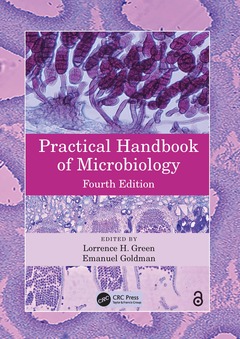Practical Handbook of Microbiology (4th Ed.)
Coordonnateurs : Green Lorrence H, Goldman Emanuel

Practical Handbook of Microbiology, 4th edition provides basic, clear and concise knowledge and practical information about working with microorganisms. Useful to anyone interested in microbes, the book is intended to especially benefit four groups: trained microbiologists working within one specific area of microbiology; people with training in other disciplines, and use microorganisms as a tool or "chemical reagent"; business people evaluating investments in microbiology focused companies; and an emerging group, people in occupations and trades that might have limited training in microbiology, but who require specific practical information.
Key Features
- Provides a comprehensive compendium of basic information on microorganisms?from classical microbiology to genomics.
- Includes coverage of disease-causing bacteria, bacterial viruses (phage), and the use of phage for treating diseases, and added coverage of extremophiles.
- Features comprehensive coverage of antimicrobial agents, including chapters on anti-fungals and anti-virals.
- Covers the Microbiome, gene editing with CRISPR, Parasites, Fungi, and Animal Viruses.
- Adds numerous chapters especially intended for professionals such as healthcare and industrial professionals, environmental scientists and ecologists, teachers, and businesspeople.
- Includes comprehensive survey table of Clinical, Commercial, and Research-Model bacteria.
The Open Access version of this book, available at http://www.taylorfrancis.com, has been made available under a Creative Commons Attribution-Non Commercial-No Derivatives 4.0 license.
Chapter 21, "Archaea," of this book is freely available as a downloadable Open Access PDF under a Creative Commons Attribution-Non Commercial-No Derivatives 4.0 license available at http://www.taylorfrancis.com
See Emanuel Goldman's Open Access article: "Lamarck redux and other false arguments against SARS-CoV-2 vaccination," https://www.embopress.org/doi/full/10.15252/embr.202254675
PRACTICAL INFORMATION AND PROCEDURES. Sterilization, Disinfection, and Antisepsis. Quantitation of Microorganisms. Culturing and Preserving Microorganisms. Stains for Light Microscopy. Identification of Gram-Positive Organisms. Identification of Aerobic Gram-Negative Bacteria. Plaque Assay for Bacteriophage. Phage Identification of Bacteria. Phage Display and Selection of Protein Ligands. Diagnostic Medical Microbiology. Modern Diagnostic Methods in the 21st Century. Antibiotic Susceptibility Testing. Bacterial Cell Breakage or Lysis. Major Culture Collections and Sources. Epidemiological Methods in Microbiology. CRISPR. SURVEY OF MICROORGANISMS. Taxonomic Classification of Bacteria. Bacterial Cell Wall: Morphology and Biochemistry. The Human Microbiome in Health and Disease. The Phylum Actinobacteria. Archaea. The Genus Bacillus. The Genus Bordetella. The Genus Campylobacter. Chlamydiae. The Genus Clostridium. The Genus Corynebacterium. The Family Enterobacteriaceae. Haemophilus Species. The Genus Helicobacter. The Genus Legionella. The Genus Listeria. The Genus Mycobacterium. Mycoplasma and Related Organisms. The Family Neisseriaceae. The Genus Pseudomonas. The Family Rickettsiaceae. Microbiological and Clinical Aspects of the Pathogenic Spirochetes. Staphylococcus aureus and Related Staphylococci. Streptococcus. The Genus Vibrio and Related Genera. Yersinia. Other Anaerobic Bacteria: Bacteroides, Porphyromonas, Prevotella, Tannerella, Fusobacterium, and Gram-positive Anaerobic Cocci. Other Gram-Negative Bacteria: Acinetobacter, Burkholderia, and Moraxella. Selected Zoonotic Pathogens. Fungi. Introduction to Parasites. Introduction to Bacteriophages. Introduction to Virology. Emerging Viruses. APPLIED PRACTICAL MICROBIOLOGY. Mechanisms of Action of Antibacterial Agents. Mechanisms of Action of Antifungal Agents. Mechanisms of Action of Antiviral Agents. Phage Therapy: Bacteriophages as Natural, Self-Replicating Antimicrobials. Emergence of Antimicrobial Resistance in Hospitals. Emerging Antimicrobial-Resistant Microorganisms in the Community. Overview of Biofilms and Some Key Methods for Their Study. Biofilms in Healthcare. The Business of Microbiology. Launching a Microbiology-Based Company. Microbiology for Dental Hygienists. Microbiology for Pre-College Teachers. Microbiology for Home Inspectors. Survey of Selected Clinical, Commercial, and Research-Model Eubacterial Species. Index. .
Edited by
Emanuel Goldman is a professor in the Department of Microbiology, Biochemistry, and Molecular Genetics of the New Jersey Medical School (NJMS), Rutgers Biomedical and Health Sciences (RBHS), a division of Rutgers University, Newark, New Jersey. He graduated with honors from the Bronx High School of Science in 1962, received a BA (cum laude) from Brandeis University in 1966, where he was a chemistry major and music minor, and completed his PhD in biochemistry at the Massachusetts Institute of Technology in 1972. He performed postdoctoral research at Harvard Medical School and at the University of California, Irvine, before joining the faculty of the New Jersey Medical School in 1979, where he rose through the ranks to professor in 1993. Among his awards and honors, Dr. Goldman was a Damon Runyon fellow, a Lievre senior fellow of the California Division, American Cancer Society, and a recipient of the Research Career Development Award from the National Cancer Institute.
Among his service activities, he was an officer and organizer of the New York–New Jersey Molecular Biology Club, served as a full member of an American Cancer Society Study Section, and continues to serve on the editorial boards of Protein Expression and Purification and Applied and Environmental Microbiology. He was also twice elected by his colleagues to serve as the president of his university’s chapter of the American Association of University Professors, and he was elected to serve as president of the Faculty Organization of NJMS. Among several areas of research activity, he has focused on the role of tRNA in the elongation of bacterial protein synthesis, including uncharged tRNA, codon bias, and programmed translational frameshifts. In addition to numerous scientific peer-reviewed publications and publications in the lay press, he has contributed a chapter to Zubay’s Biochemistry textbook and four chapters to the
Date de parution : 05-2023
21.5x27.9 cm
Date de parution : 05-2021
21.5x27.9 cm
Thèmes de Practical Handbook of Microbiology :
Mots-clés :
Microbiology; Microbiology procedures; Business of Microbiology; Sterilization; Disinfection; Antisepsis; Bacteria; Bacteriophage; Parasites; Fungi; Virus; Johne's Disease; Integrative Conjugative Elements; DNA DNA Hybridization Study; MERS; Vancomycin Resistant Enterococci; Lyme Borreliosis; DNA DNA Hybridization; Antimicrobial Resistance; Phage DNA; MRSA Infection; DNA Transfer; Phage Dilution; Phage Therapy; Broth Microdilution; Camp Test; Phage Typing; MLST Analysis; HMW DNA; MALDI TOF MS; BD Diagnostic System; NAAT; Phage Particle; Biofilm Formation; Gram Stain; SFG Rickettsiae
